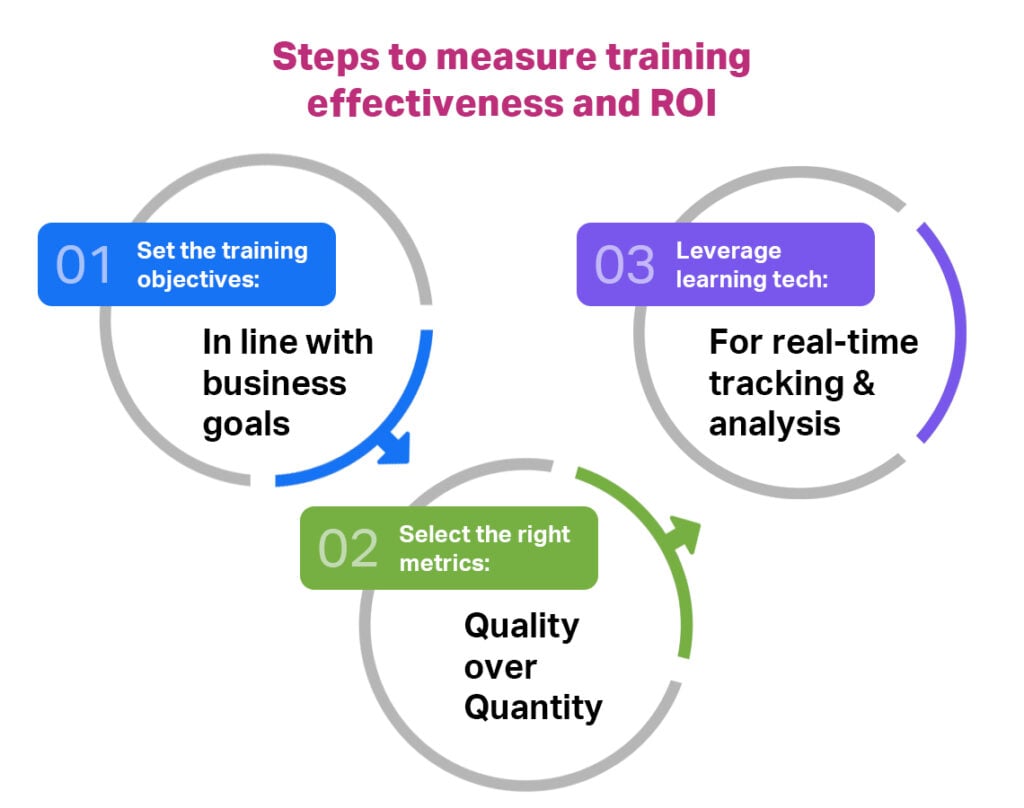
6 min read
• 28 Mar 2024
How To Measure Employee Training Effectiveness and ROI with Learning Analytics
Learning analytics are essential to measure employee training effectiveness and value in order to boost L&D ROI.
-
eBookEmployee Upskilling - A Detailed Blueprint For Building A Skills-Driven Learning Culture
Today’s competitive job market has made it more important than ever for companies to invest in employee training and upskilling programs. This is a requirement to stay competitive while benefiting from better overall job performance and higher retention and engagement rates.
To maximize ROI, it’s critical to continuously measure learning analytics to determine your training program’s level of effectiveness, value, and impact. This will ensure you are reaping full benefits for your efforts.
What Is the purpose of learning analytics?
Leveraging learning analytics helps you track learning progress and links it back to the business impacts. These analytics also provide insights on predictive crucial trends like attrition and the time and resources spent on training versus the return on investment.
Leveraging learning analytics to measure employee training effectiveness and ROI is essential in ensuring you’re not wasting or misusing resources with a lackluster training program. The collection of learning-related data and monitoring of your learning analytics provides valuable visibility into the effectiveness, relevance, and responsiveness of your employee training program. This also measures how this program is impacting your learners and the learning environment itself.
Measuring learning analytics allows you to optimize your training program using data-driven insights to improve performance outcomes, cost effectiveness, and ROI.
4 Types of Learning Analytics
When measuring learning analytics to determine ROI of employee training, you’ll want to gather following types of data to answer any questions you might have:
- Descriptive Analytics – The overview of the state of your training program.
- Diagnostic Analytics – The details behind it, such as causes, areas of improvement, patterns, and relationships.
- Predictive Analytics– Estimates about the consequences of different actions and probabilities based on approximate variable predictions using data about past patterns and behaviors.
- Prescriptive Analytics – Offers possible solutions using vast data sets and specialized algorithms.
3 Steps for Measuring Employee Training Effectiveness and ROI
Learning analytics allow you to quantify the value and impact of training on employee performance, team performance, engagement, retention, and business results versus the cost of time and resources being invested. Here are 3 steps to ensure you are taking the right approach when using learning analytics to measure training effectiveness and ROI:

1. Set employee training perspectives
The first step is to set the objectives of your employee training program and learning analytics initiatives, making sure they’re in line with business goals and creating a plan to meet them. It’s important to ensure that these objectives align with your overall business goals.
2. Focus on quality over quantity when collecting data
It’s important to be precise and intentional with data collection. It can be tempting to take a more is better approach, collecting as much data as possible, but this may leave you with more questions than answers. Remember that when measuring data for your employee training program, quality trumps quantity.
Purposefully collecting relevant data surrounding this will make sure you can properly evaluate. 4 learning metrics to consider collecting are:
- Time-to-competency: Tracking and measuring how quickly employees master a new skill with the goal of reducing time to competency over time
- Knowledge retention: Tracking and measuring how much knowledge employees are retaining; levels of retention can confirm if training is effective or not
- Knowledge application: Tracking and measuring if employees are applying their learning on the job; improved performance, greater level of knowledge and competency help gauge the effectiveness of training
- Employee feedback: providing important insights into how training is being received, levels of engagement, relevance, and effectiveness
3. Leverage learning technology for learning analytics
Leveraging technology for learning analytics makes collecting, analyzing, and tracking key data quicker and more efficient. It allows you to instantly create customized reports on things like employee training progress, drop off, pass rate, or time spent training, to name a few.
These reports help you identify patterns that can be used to uncover which portions of training are going well and which need work.
Utilize an AI-Powered LXP for Learning Analytics
An AI-powered learning experience platform provides you with a unified view of the diverse learning metrics that matter when determining L&D ROI. It allows you to track key insights and data quickly as well as to spot patterns and get a deeper understanding of why portions of your training program need improvement. This is done through:
- Seamless data visualization: You can see if your employees are engaging with your courses and if they’re completing them. You can also see the login frequency and time spent on each course.
- Smart filters: You can add a variety of custom filters to instantly find the information you need. For example, you can set a filter to report data for employees based on location, to see which learning approach or type of material works best by country.
- Advanced analysis through slices and dices: You can add unlimited analytics pages and apply cuts to break down data across modules, user types, and location, to name a few. You can even identify which courses employees are adopting better than others.
- Flexibility to customize: You can decide how you want to view your data, through customizable reports, charts, graphs, or diagrams, and have them delivered to your inbox. You can even automate this process to save time.
Why Employee Training Matters
A quality employee training program is a key factor in attracting, engaging, and retaining top talent. It plays an enormous part in fostering high-performing teams who are able to achieve strategic goals.
If you’re ready to unlock your team’s potential, boost ROI, and improve your business results by personalizing and optimizing your employee training program, schedule a demo with Disprz today.
About the author

Debashree Patnaik
Debashree is a seasoned content strategist at Disprz.ai, specializing in enterprise learning and skilling. With diverse experience in B2B and B2C sectors, including ed tech, she leads the creation of our Purple papers, driving thought leadership. Her focus on generative AI, skilling, and learning reflects her commitment to innovation. With over 6 years of content management expertise, Debashree holds a degree in Aeronautical Engineering and seamlessly combines technical knowledge with compelling storytelling to inspire change and drive engagement.
More Resources
4 min read
• 15 Apr 2024
Unlocking the Power of Managerial Engagement in Talent Development
4 min read
• 09 Apr 2024
Nurturing Excellence in Building Leadership Pipelines
Sign up to get free resources and stay up to date with Disprz!
Discover how Disprz can align learning and upskilling with your desired business outcomes.





